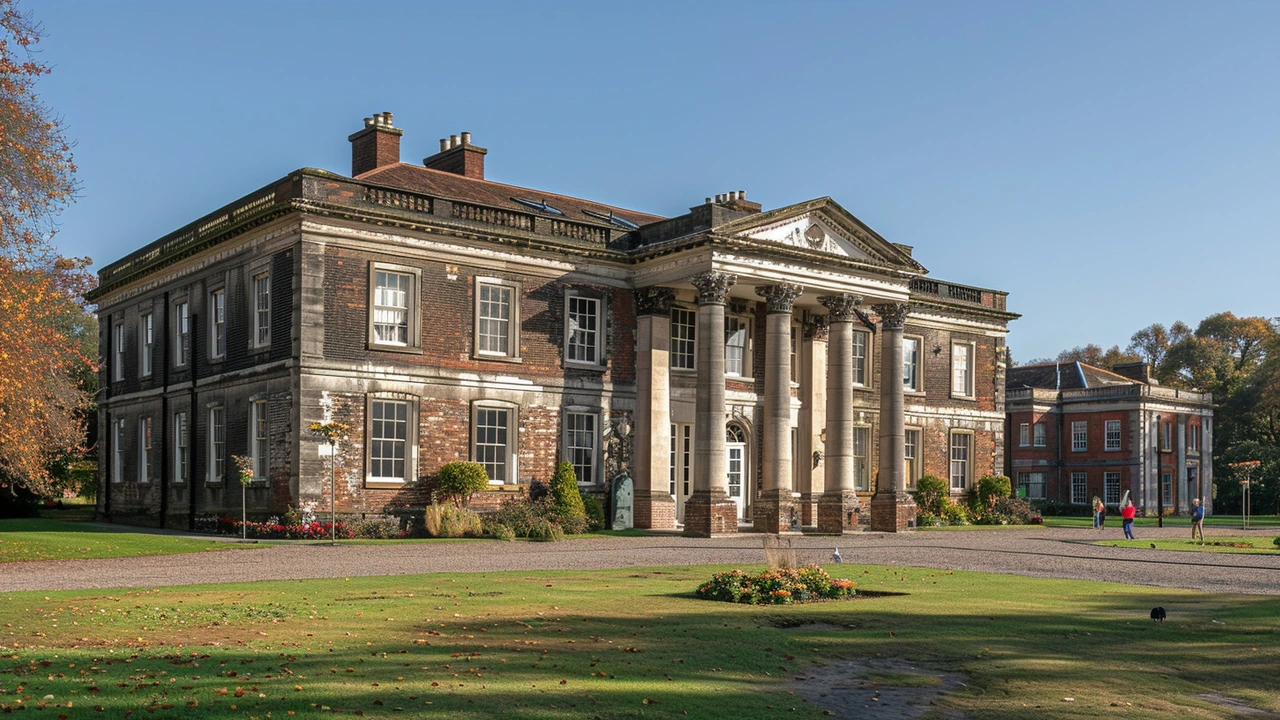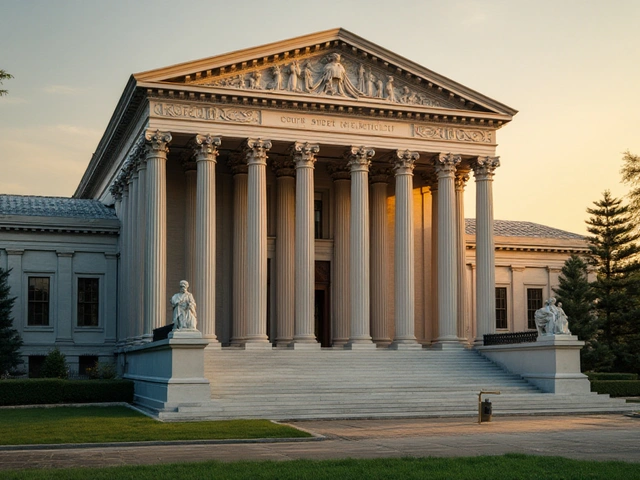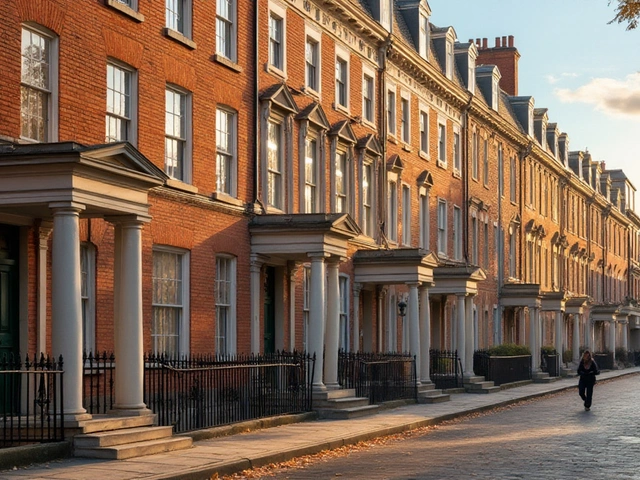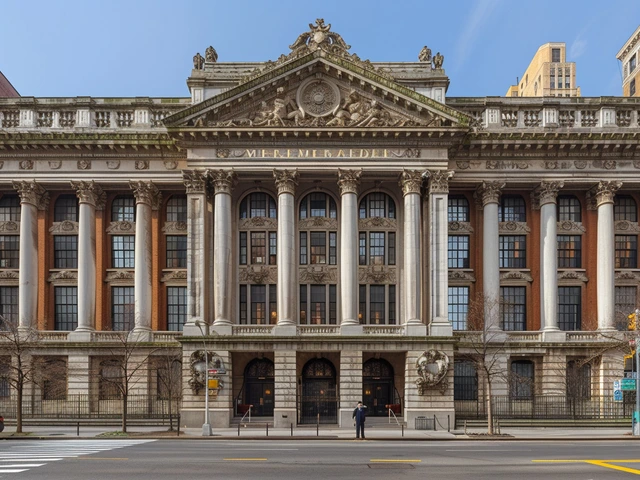Federal architecture is a notable chapter in the architectural history of the United States, emerging between 1780 and 1830. This style came to life in the post-revolutionary period, drawing much inspiration from the ancient Roman and Greek architecture beloved by the young nation's founding fathers.
Characterized by its refined elegance, Federal architecture blends simplicity with grandeur. The use of brick, wood, and stone, often adorned with decorative elements like fanlights and balustrades, offers a distinct yet sophisticated aesthetic.
Many iconic American buildings boast this style, showcasing the country's rich history and the vision of architects like Charles Bulfinch and Benjamin Latrobe. These structures not only tell the story of early American life but also highlight the evolving artistic narrative of a burgeoning nation.
Understanding the nuances of Federal architecture allows for greater appreciation of its subtle details and historic significance. Whether strolling through a historic district or visiting a national landmark, recognizing the hallmark features of this style enriches the experience and connects us more closely with the nation's architectural legacy.
- The Origins of Federal Architecture
- Key Features and Characteristics
- Iconic Federal Buildings in America
- Notable Architects and Their Contributions
- How to Appreciate and Identify Federal Architecture
The Origins of Federal Architecture
Federal architecture, also known as the Adam style, emerged in the late 18th century just as the United States was gaining its independence. This architectural style coincided with a period of great optimism and national pride, reflecting the country's new political identity. The young nation's architects sought to move away from the Colonial Georgian style that was popular under British rule, opting for a design that would symbolize the democratic ideals of the new republic.
The style was named after the Federalist Party, which was dominated by figures like George Washington, John Adams, and Alexander Hamilton. They favored classical architecture as a way to express the ideals of democracy and civic virtue. By drawing on Ancient Greek and Roman designs, the architecture of this period aimed to symbolize strength, wisdom, and permanence. The inspiration mainly came from the British architect Robert Adam, whose neoclassical designs influenced American architects.
Thomas Jefferson, an ardent admirer of classical architecture, was one of the most prominent advocates of this style. He believed that architecture was more than just building; it was a form of art that could educate and inspire. His Monticello estate in Virginia is one of the earliest and finest examples of Federal architecture. Jefferson’s preference for simplicity and proportion set the tone for much of the Federal architecture that followed.
In cities like Boston, Philadelphia, and Washington, D.C., this architectural style gained traction quickly. Its defining characteristics—symmetry, geometric shapes, and the use of elements like domes and columns—soon became synonymous with public buildings, banks, and residences. Interestingly, this style reflected a sort of architectural rebellion, where artisans felt free to experiment with new building techniques and materials, pushing the boundaries of what was previously accepted in Colonial America.
An illustrative case of the Federal style is the Massachusetts State House, designed by Charles Bulfinch, one of the first native-born American architects. Completed in 1798, it exemplifies the clean lines, red brick walls, and elegant domes that are hallmarks of the style. Bulfinch's work had profound influence, and many young architects, inspired by his designs, helped spread Federal style across the eastern United States.
Despite its popularity, Federal architecture often embraced local materials and craftsmanship, making each building unique while still adhering to the common stylistic principles. This approach led to comfortable yet stylish homes that were affordable to more than just the elite, subtly democratizing American design.
“Federal architecture provided the visual language for the new American republic,” explains architectural historian Roger G. Kennedy. “Its emphasis on symmetry and proportion symbolized the balanced government and enlightened principles that the nation aspired to.”
As the country expanded westward, the Federal style continued to be a preferred choice, symbolizing the nation's progress and the values it held dear. It wasn't just an architectural style; it was an embodiment of national identity and a cherished piece of America's cultural heritage.
Key Features and Characteristics
Federal architecture stands out due to its refined elegance and subtle grandeur. One of its hallmarks is symmetry. Buildings often feature balanced and proportioned facades, drawing the eye to a centered doorway or series of evenly spaced windows. This symmetry reflects the influence of Ancient Roman and Greek architecture, which emphasized harmony and order.
The use of decorative elements is another defining characteristic. For example, fanlights—semi-circular or elliptical windows often found above doors—add a distinct charm to Federal-style structures. These features not only enhance natural light but also serve as decorative focal points. Equally appealing are the sidelights, narrow windows flanking the main door, contributing to the overall aesthetic.
Materials used in Federal architecture also offer insights into its style. Brick and wood are common, with exteriors frequently painted in light, neutral colors. These materials lend a clean and crisp appearance that echoes the restrained elegance of the period. Stone is another material used, especially in larger public buildings, to provide a sense of sturdiness and permanent strength.
Interior details are no less captivating. Ornate moldings, intricately carved mantels, and wainscoting create an atmosphere of quiet sophistication. The use of plasterwork, often in the form of ceiling medallions or cornice moldings, adds another layer of decorative appeal. These elements combine to create interiors that are visually engaging, yet not overly ostentatious.
Additionally, the influence of designers such as Robert Adam is evident in many fine Federal buildings. Adam was known for integrating classical elements with a contemporary flair, favoring oval rooms and domed spaces. This innovation within the constraints of symmetry and proportion keeps Federal architecture from feeling too rigid or predictable.As noted by the National Park Service, "The delicate details and lack of ostentatious ornament are characteristic of Federal design."
Windows in Federal buildings are also notable. Typically, they are sash windows with multiple panes, often six-over-six or nine-over-nine. These configurations were not just a stylistic choice but also a practical one, reflecting the limitations of glass-making techniques of the time. Today, these windows continue to enchant, offering glimpses into an era characterized by both practical and aesthetic advancements.
Landscaping around Federal buildings is another aspect to consider. Gardens were often designed to complement the symmetry and balance of the house. Paths, hedges, and even the choice of plants were arranged to add to the harmonic appearance, making these homes feel like serene retreats amidst the bustling world.
Iconic Federal Buildings in America
Federal architecture has gifted the United States with some of its most treasured landmarks. One of the most distinguished examples is the Massachusetts State House in Boston. Designed by Charles Bulfinch and completed in 1798, this building stands out with its golden dome and elegant proportions, echoing the style's commitment to symmetry and classical influences. Bulfinch’s touch to the American architectural landscape is undeniable.
A journey to Washington, D.C., reveals several other sterling Federal buildings. The White House, perhaps the most famous of all, reflects the Federal style in its use of sandstone, large windows, and classical detailing. What many find fascinating is how James Hoban’s original design has weathered the test of time, encapsulating both the simplicity and grandeur of Federal architecture.
Another notable structure in the capital is the United States Capitol. Both William Thornton and Benjamin Henry Latrobe contributed to this masterpiece, which holds significant historical and architectural value. While Thornton’s initial design laid the groundwork, Latrobe integrated more Federal stylistic elements, such as elegant columns and domes drawing inspiration from ancient Rome. Seeing the Capitol up close enables one to truly grasp the intricate details that typify the Federal aesthetic.
“The Capitol is not only a symbol of American democracy; its architecture stands as a testament to the artistry and vision of the early American architects,” said historian David McCullough.
Moving to the South, the Octagon House in Washington, D.C., built between 1799 and 1800, offers an insightful glimpse into the Federal style. This house is known for its unique, octagonal layout and detailed interior woodwork. Nowadays, it serves as a museum displaying period furnishings and historical artifacts, allowing visitors to step back in time.
In Philadelphia, the Second Bank of the United States ranks high on any architectural enthusiast’s list. Designed by William Strickland and completed in 1824, this building showcases the strong influence of Greek Revival intertwined with Federal style. Its stately columns and pediment echo the grandeur of ancient temples, making it an essential stop on any tour of Federal architecture.
These iconic structures symbolize more than just architectural prowess; they capture the spirit of a young nation forging its identity. Visiting these buildings offers a deep appreciation for the attention to detail and historical significance embedded within their walls. Next time you stroll past an imposing columned facade or admire a delicately fanlit doorway, remember that these elements are part of a broader narrative that spans centuries and continues to inspire.
Notable Architects and Their Contributions
The magic of Federal architecture could not have been woven without the brilliance of certain architects who left indelible marks on this style. These visionaries were not only builders but also artists and pioneers who embraced the aesthetic and functional potential of Neoclassical design.
Charles Bulfinch stands out as a significant figure in Federal architecture. Often credited as one of the first professional American architects, Bulfinch’s work in Boston, including the Massachusetts State House, epitomizes the elegance and proportionality of Federal design. His attention to symmetry, incorporation of classical elements like columns and domes, and innovation in urban planning have left a lasting impact on the architectural landscape.
Another luminary, Benjamin Henry Latrobe, brought a meticulous and artistic approach to his designs. Best known for his work on the United States Capitol, Latrobe's contributions extended the Federal style’s reach. His design integrated classical influences with a distinctively American flair, evidenced by the symbolic imagery in the Capitol's interior. Latrobe also designed several important buildings in Philadelphia and Washington, D.C., where his attention to detail and classical influences shone brightly.
Samuel McIntire, a skilled woodcarver and architect from Salem, Massachusetts, is another key figure. McIntire’s work in residential architecture, such as the Peirce-Nichols House, shows an extraordinary blend of functionality and artistry. His designs often included intricate woodwork and elegant proportions that were quite advanced for his time. McIntire's ability to harmonize decorative elements with structural integrity made his buildings not only beautiful but enduring.
“Architecture is the learned game, correct and magnificent, of forms assembled in the light.” – Le Corbusier
Yet another noteworthy contributor, Robert Mills, brought national attention to the Federal style with his designs for public buildings. Mills, who designed the Washington Monument, was adept at using monumental scale to evoke a sense of grandeur. His buildings often featured classic elements such as porticos and domes, which he adeptly combined with Federal style motifs.
The efforts of these architects were foundational in shaping not just Federal architecture but the visual and cultural identity of a young United States. By incorporating elements from ancient Rome and Greece, combined with their innovation and artistry, they created buildings that stood the test of time. For anyone interested in the elegance of Federal architecture, understanding the contributions of these key figures sheds light on the origins of this timeless style and provides deeper appreciation for its sophisticated beauty.
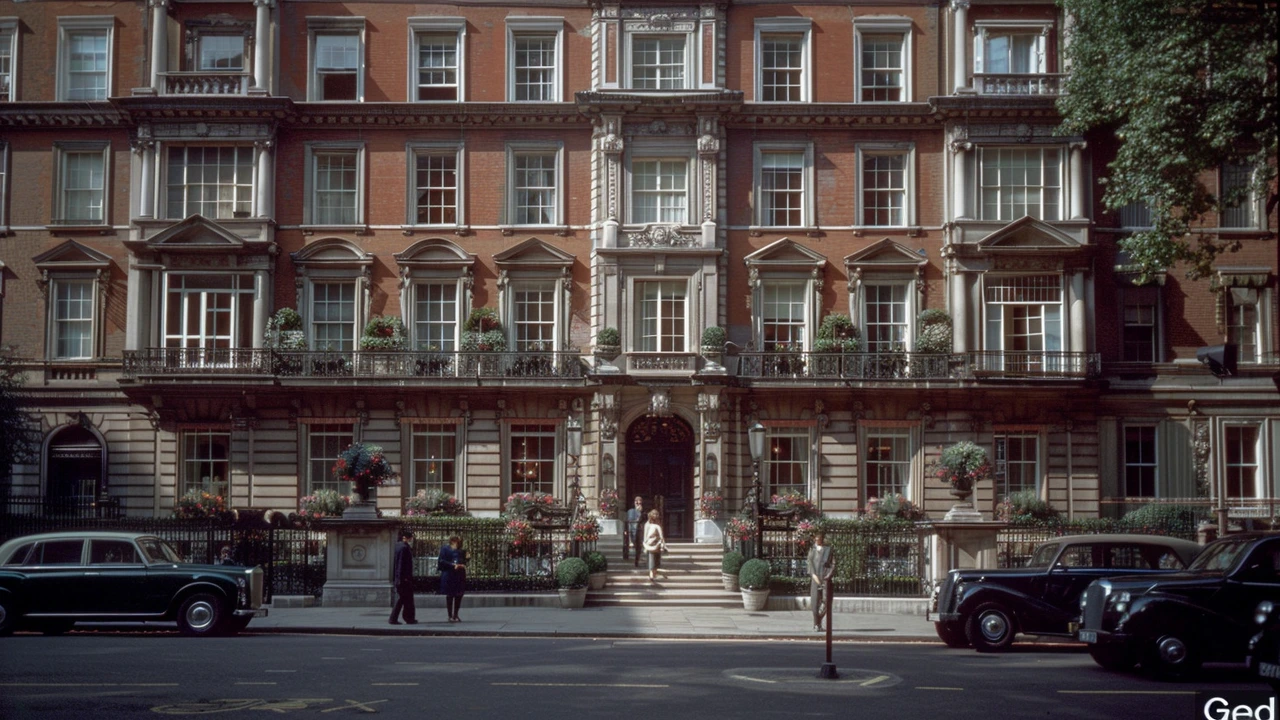
How to Appreciate and Identify Federal Architecture
Recognizing and admiring Federal architecture entails understanding its unique characteristics and historical context. Begin with the realization that this style represents the aspirations of a newly independent nation aiming to reflect its democratic ideals through elegant, classical forms. The use of symmetry is a standout element in Federal architecture. Buildings often feature balanced windows and doors, aligned perfectly around a central axis, giving a harmonious and pleasing aesthetic.
Another notable aspect is the restrained use of ornamentation. Unlike the more elaborate Georgian style preceding it, Federal architecture exudes an understated elegance. Fanlights—semicircular windows usually placed above the front door—are common, along with decorative swags and garlands crafted with intricate detail yet maintaining a sense of simplicity. Have you ever noticed these refined touches? Paying attention to these elements can reveal the building's architectural lineage.
Federal-style buildings often boast flat or low-pitched roofs, sometimes accented with a balustrade. The exterior is typically brick or wood, but stone can also be used. In urban settings, you might find tall, narrow townhouses that seem to stretch towards the sky, a design adapted to compact city living. Such structures echo the historical shift from rural to urban life in early America.
Interiors of Federal buildings are equally captivating. Spaces are often grand yet cozy, with high ceilings and large windows that let in ample light. Look for elaborate plasterwork on the ceilings and mantels, as these feature the neoclassical motifs popular at the time. Could you imagine living in such detailed splendor?
To truly appreciate Federal architecture, it helps to know some of the masterpieces. Take a virtual tour or, better yet, visit in person to see the Maryland State House or Massachusetts State House. These buildings exemplify the Federal style at its finest and offer a tactile sense of history. Analyzing these landmarks can deepen your appreciation of the architectural choices and their historical context.
“Architecture is the reaching out for the truth.” — Louis Kahn
One of the joys of exploring Federal architecture is discovering the works of pioneering architects like Charles Bulfinch and Benjamin Latrobe. Their designs not only informed the Federal style but also laid the groundwork for future generations of American architecture.
When identifying Federal-style buildings, begin with these primary features:
- Symmetry in design
- Fanlights and sidelights around doors
- Use of brick and wood
- Flat or low-pitched roofs
- Restrained ornamentation
Keep these aspects in mind as you explore. This awareness enriches your experience and deepens your connection to the nation's architectural history. Ultimately, appreciating Federal architecture is about more than recognizing style—it's about connecting with the vision and values of a new nation expressed through thoughtful design.

